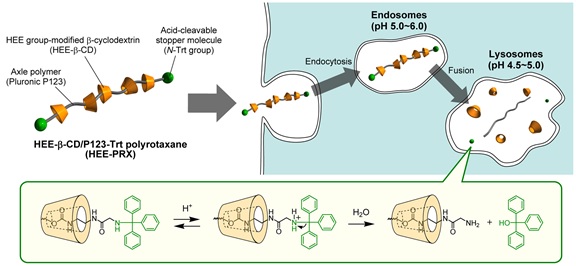Researchers in Japan have improved a potential treatment for a rare genetic disease, decreasing its negative toxic effects by threading it onto a dumb-bell-shaped chain and holding it in place until it reaches its target.

The by-products of cellular processes need to be removed and degraded for cells to function normally. Tiny spherical vesicles, called lysosomes, act as the cell’s main waste disposal system. Genetic abnormalities that affect them lead to waste accumulation inside cells.
Niemann-Pick type C (NPC) disease is a rare genetic disorder that affects two proteins that play a central role in transporting cholesterol from lysosomes to other parts of the cell. Accumulation of cholesterol inside lysosomes leads to fatal symptoms, such as progressive nerve degeneration, and enlargement of the liver and spleen.
[pullquote]The team’s compound has “great potential to improve lysosomal cholesterol accumulation in NPC disease without marked toxicity,” conclude the researchers in their study published in the journal Science and Technology of Advanced Materials.[/pullquote]
A team of researchers at Tokyo Medical and Dental University are working to improve the efficiency of a drug that has received much attention due to its strong ability to reduce cholesterol in cells affected by NPC. However, high concentrations of these potentially therapeutic ring-shaped sugar molecules, called HP-β-CD (2-hydroxylpropyl-β-cyclodextrin), were found to be highly toxic in mice.
The researchers developed a strategy to deliver HP-β-CD to lysosomes without affecting other cell structures. They did this by threading the ring-shaped HP-β-CDs onto a dumb-bell-shaped molecule, called polyrotaxane. A “stopper”, called N-Trt (N-triphenylmethyl), is present at either end of the polyrotaxane molecule, keeping the HP-β-CD in place on its polyrotaxane thread. The team also added a molecular component, called an HEE group (2-(2-hydroxyethoxy)ethyl), to the HP-β-CD part of the compound, making it more soluble in water.
The team found that the N-Trt stoppers were broken off when the compound reached the acidic environment of the lysosomes, but stayed mainly intact in the largely neutral environment of the surrounding cell. They also found that the compound reduced cholesterol levels inside cells best when 4.1 to 5.4 HEE groups were added per single β-CD. When the number of HEE groups was increased, the compound was unable to reduce cholesterol content. Finally, the compound showed negligible toxicity in normal human skin cells called fibroblasts, even at relatively high concentrations.
The team’s compound has “great potential to improve lysosomal cholesterol accumulation in NPC disease without marked toxicity,” conclude the researchers in their study published in the journal Science and Technology of Advanced Materials.







